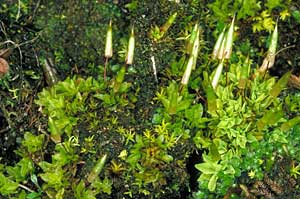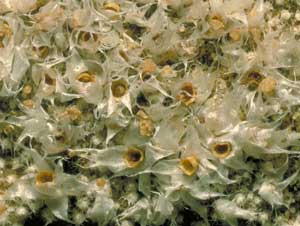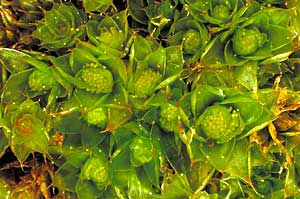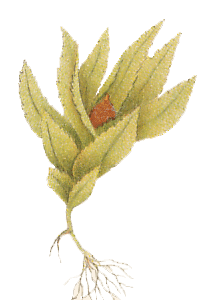
Bryogeography – Australia and elsewhere
Australia and far away
On this page you will see examples of bryophytes that, while found in Australia, are also found in areas well away from Australia.
Widespread – cosmopolitan to disjunctive
A number of bryophytes have widespread distributions, some being cosmopolitan or virtually so. To say that a species is cosmopolitan is not the same as saying it turns up everywhere. Many bryophytes have specific substrate or habitat preferences. For example, a species that must have tree trunks as substrate may well be found in almost all continents, but obviously not in Antarctica and not in the treeless deserts of Africa, Australia, Eurasia and the Americas. Such a species would still be an example of a cosmopolitan bryophyte.
The mosses Brachythecium rutabulum, Bryum argenteum ![]() , Ceratodon purpureus, Leptobryum pyriforme, Polytrichum commune and Polytrichum juniperinum
, Ceratodon purpureus, Leptobryum pyriforme, Polytrichum commune and Polytrichum juniperinum ![]() are cosmopolitan. Some would consider Bryum argenteum to be the most widespread plant on the earth and both it and Ceratodon purpureus grow on the Antarctic mainland. Amongst the thallose liverworts the species Lunularia cruciata
are cosmopolitan. Some would consider Bryum argenteum to be the most widespread plant on the earth and both it and Ceratodon purpureus grow on the Antarctic mainland. Amongst the thallose liverworts the species Lunularia cruciata ![]() , Marchantia polymorpha, Metzgeria leptoneura, Reboulia hemisphaerica, Riccia bifurca, Riccia crystallina, Riccia nigrella
, Marchantia polymorpha, Metzgeria leptoneura, Reboulia hemisphaerica, Riccia bifurca, Riccia crystallina, Riccia nigrella ![]() , Ricciocarpos natans
, Ricciocarpos natans ![]() and Targionia hypophylla
and Targionia hypophylla ![]() are very widespread to cosmopolitan. Marchantia polymorpha gives a good example of a "cosmopolitan but not everywhere" distribution. In the tropics it is not found in lowland areas and so, while present in Africa and Eurasia, is absent from much of the tropical parts of those areas. Anthoceros punctatus and Phaeoceros carolinianus are examples of cosmopolitan hornworts.
are very widespread to cosmopolitan. Marchantia polymorpha gives a good example of a "cosmopolitan but not everywhere" distribution. In the tropics it is not found in lowland areas and so, while present in Africa and Eurasia, is absent from much of the tropical parts of those areas. Anthoceros punctatus and Phaeoceros carolinianus are examples of cosmopolitan hornworts.
Amongst the cosmopolitan bryophytes there are those that have been spread unintentionally by humans (e.g. as contaminants of trade goods) as well as those that have become widespread without the help of human agents. Sometimes it's difficult or impossible to determine the cause of the wide distribution. There are however some cases where the case for human spread is well-supported and you can find out more in the IMPORTS AND EXPORTS page. Of the bryophytes listed in the previous paragraph Bryum argenteum, Lunularia cruciata and Marchantia polymoprha are good examples of species that do well in human-modified habitats, though not necessarily confined to such habitats. They are species that have almost certainly been introduced to some areas by humans.
So far there seem to be few cosmopolitan leafy liverworts and it may be that there really are few such species. However the taxonomy of leafy liverworts has been confusing in the past, with many species names used unclearly or incorrectly and some of the problems are outlined in the OLD LITERATURE AND NEW IDEAS page. Some leafy liverwort species can show marked variations in growth form under different ecological conditions, sometimes making it a challenge to determine if there is just one species or more. Clearly a better understanding of variation within and between species would yield a much better idea of species distributions. For the moment Cololejeunea minutissima is one widely-accepted example of a cosmopolitan leafy liverwort, though one school of thought holds that this species really represents a number of different, regional species rather than one cosmopolitan species. Calypogeia arguta is known from Africa, Eurasia, New Guinea and Australia. In North America the species Calypogeia sullivantii is widespread in at least the east and is very similar to Calypogeia arguta, even "doubtfully distinct" from Calypogeia arguta according to some bryologists. If the two species were one, it would be close to cosmopolitan.
The pantropical species show a more limited, but still very wide distribution, being found throughout the tropical areas of the world. Examples of these, with Australian representatives, are the mosses Erpodium biseriatum, Groutiella tomentosa and Splachnobryum obtusum. Diplasiolejeunea cavifolia, Leptolejeunea maculata and Lopholejeunea nigricans are pantropical leafy liverworts which are found in Australia. Some predominantly pantropical species extend in varying degrees into the northern or southern temperate areas. An example of this is the moss Gemmabryum coronatum, which you will find as Bryum coronatum in many references, and in Australia it is found in parts of southern Australia as well as the subtropical to tropical areas of New South Wales and Queensland.
The paleotropical species are those that are not found in the Americas but are found elsewhere in the tropical to sub-tropical zone. The following are examples of bryophytes that are widespread in the paleotropics, from Africa, through Asia, into Australia and on to the Pacific:
leafy liverworts: Acrolejeunea aulacophora, Cheilolejeunea decursiva, Cololejeunea lanciloba
, Frullania apiculata, Notoscyphus lutescens, Ptychanthus striatus
mosses: Brachymenium nepalense, Calymperes graeffeanum, Mitthyridium fasciculatum, Rhodobryum aubertii, Syrrhopodon armatus
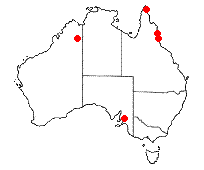 |
There are various bryophytes that are found in widely separated areas of the world, but not in between. Such bryophytes are referred to as disjunctive species. In the initial BRYOGEOGRAPHY page you came across an example, Tayloria rudolphiana, which is found in Europe and China. That page noted that, given the current limited knowledge, it was difficult to come up with a convincing explanation of that disjunction. Some disjunctions lend themselves more readily to plausible hypotheses. The moss Archidium capense is known only from South Africa and Australia and the red dots on the accompanying map show its distribution in Australia. As you can see, even in Australia the species has a disjunctive distribution. This is likely to be an artificial effect, given the small size of Archidium capense plants. The spores of are more than a tenth of a millimetre in diameter and therefore unsuitable for long-distance wind dispersal. In this case a Gondwanan ancestry would be a plausible assumption – but the mere occurrence of the species in Australia and South Africa is not immediately proof of Gondwanan ancestry. There's more about disjunctions in the PROBLEMS AND PUZZLES page which also gives some examples of disjunctive distributions within Australia. There's more about bryophytes in Gondwanan areas a little further on in this page.
Amongst the disjunctive bryophytes are the bipolar species, which are absent (or virtually so) from the tropics but are present in at least some other areas of each of the northern and southern hemispheres. The exact number of bipolar species is uncertain but there are estimates of about 100 such mosses but possibly no more than 20 such liverworts and there seem to be no bipolar hornworts. The term bipolar is well-established but somewhat misleading, since the species concerned need not be confined to the near-polar areas. The moss Andreaea heinemannii is a good example. In Australia it has been found in alpine or sub-alpine areas of New South Wales and Victoria. Outside Australia it occurs in New Zealand and Kerguelen Island and is widespread in the northern hemisphere – southern Europe, the Caucasus, Macaronesia, Greenland and western North America. It is typically found growing on exposed basalt rock at high elevations. Encalypta vulgaris, another moss, is found in Tasmania and many parts of south-east mainland Australia as well as New Zealand, North America, North Africa, Europe and other parts of Eurasia. The moss Brachythecium salebrosum, shown here ![]() growing in the lawn at Old Parliament House in Canberra, is found in eastern Australia in various areas from Brisbane to Tasmania, New Zealand, Kerguelen Island and, in the Northern Hemisphere, is widespread in North America and Eurasia. The leafy liverwort Calypogeia sphagnicola is widespread in the Northern Hemisphere (North America, Greenland, Iceland, Europe and Asia) and, in the Southern Hemisphere, is found in Tasmania, New Zealand and Tierra del Fuego.
growing in the lawn at Old Parliament House in Canberra, is found in eastern Australia in various areas from Brisbane to Tasmania, New Zealand, Kerguelen Island and, in the Northern Hemisphere, is widespread in North America and Eurasia. The leafy liverwort Calypogeia sphagnicola is widespread in the Northern Hemisphere (North America, Greenland, Iceland, Europe and Asia) and, in the Southern Hemisphere, is found in Tasmania, New Zealand and Tierra del Fuego.
Some bipolar species have a very unbalanced north-south distribution and the leafy liverwort Scapania obcordata (not found in Australia) is a good example. In the Northern Hemisphere it is found widely scattered through North America, Greenland and Eurasia, generally north of the 60° latitude line, but with a couple of isolated localities in the Altai and North Ural mountains. In the Southern Hemisphere it has been found only in the sub-Antarctic on Signy and King George Islands, a little south of the 60° latitude line.
The evidence to date suggests that many of the bipolar species originated in the Northern Hemisphere. A bipolar distribution may possibly result from long-distance dispersal of propagules, though long-distance east-west dispersals are far easier to explain than north-south ones. Alternatively, a bipolar distribution could be the result of a once-widespread distribution shrinking to leave a broad equatorial gap. Some people have suggested that, during extensive glacial periods, cold-loving species that are normally found at high latitudes can colonize areas closer to the equator. In such circumstances it would be easier for a species to cross to the other hemisphere. At the end of a glacial period, as the equatorial and near-equatorial areas warm up, many cold-loving species are likely to be forced back to the higher latitudes, with some species ending up in the higher latitudes of both hemispheres and so creating a bipolar distribution. In the post-glacial period the cold-loving species could also retreat to alpine peaks in the tropics.
The leafy liverwort Anthelia juratzkana is widely distributed in the arctic or alpine regions of the non-tropical areas of the Northern Hemisphere. In the non-tropical areas of the Southern Hemisphere it is found in New Zealand, Tierra del Fuego and various sub-Antarctic islands south to east of the southern tip of South America. The species is also found on some high tropical mountains in South America, east Africa and Papua New Guinea. The American liverwort exper Rudolf Schuster has described this species as:
...copiously fertile....."weedy" and an aggressive colonizer in exposed, "difficult" sites where competition is limited or lacking, often where snow or ice persist long into the growing season.
Another leafy liverwort, Lophozia excisa, has a similar distribution except that there are no records of it from the tropics. The distribution of the moss Warnstorfia sarmentosa resembles that of Anthelia juratzkana to a fair degree - but it is also found in alpine New South Wales and a number of Chinese and Central Asian localities. The leafy liverwort Cephaloziella varians is widespread in the Holarctic. In the Southern Hemisphere it is found at high elevations in south-eastern Australia and also in New Zealand, various sub-Antarctic islands and in many ice-free places on the Antarctic mainland, to a latitude of 77 degrees south. It is the commonest liverwort in Antarctica![]() .
.
We'll finish this section with two examples of widespread, disjunct mosses that are found in Australia and have distribution patterns different to any so far mentioned. Gigaspermum repens is widespread in Australia, particularly in the inland areas, and is also found in New Zealand, Mexico, southern Africa and Madagascar. Another species, Gigaspermum mouretii occurs in some of the countries bordering the Mediterranean, but some bryologists wonder if the two are really the same species. Zygodon gracillimus is found in Tasmania, New Zealand, Java and Bolivia.
South America, Africa, Antarctica
These three regions, along with Australasia and India, formed the ancient super-continent of Gondwana. During and after the break-up of Gondwana each of the non-Antarctic areas moved north, with India moving furthest to finish up north of the equator. Many of the Gondwanan bryophytes that were originally in India would have disappeared during the move from the cool and moist southern areas, through the hot equatorial zone and into an area where it is now seasonally dry – but others would have survived in suitable niches. Various Eurasian bryophytes would have been able to migrate into India after it joined Eurasia so the bryological history of India is quite complex with the Gondwanan heritage likely to be well masked. Australia, Africa and South America also moved north, but not as far, and though the latter two straddle the equator their southern extremities are still a long way south.
In Gondwana eastern and southern Africa and the southern part of South America were the areas of those continents closest to Australia. That's not to say that all were particularly close since Antarctica lay between Australia and Africa-South America. Nevertheless today there are still many species that are largely confined to these "Antarctic neighbourhood" areas of the Southern Hemisphere. Incidentally, the American liverwort specialist, Rudolf Schuster has presented reasons as to why the Southern Hemisphere's liverwort flora is much more varied and interesting than that of the Northern Hemisphere. His argument is summarised in the SOUTHERN DIVERSITY CASE STUDY![]() .
.
In this section we'll look at some examples of bryophytes which are found in Australia as well as one or more of Antarctica and the southern areas of Africa and South America. Some are also found in the intervening islands and in non-Gondwanan areas. In South America the Andes and the narrow strip between them and the Pacific Ocean have provided (and continue to provide) a suitable migratory avenue for many species. In particular the Andes have been the means by which cold-loving species could move well north. From northern South America the Central American land bridge opens the possibility for further migration into North America. In Australia the Great Dividing Range and the narrow strip between it and the Pacific Ocean have provided a fairly moist and well-vegetated south-north conduit. From the Cape York Peninsula it would be possible for bryophytes to move to the island of New Guinea. Leptostomum is a Gondwanan moss genus, found in both southern South America and Australasia. There's some difference of opinion as to how many species the genus has but the number is about ten. While, as a genus, Leptostomum is widespread in the Gondwanan areas, no single species is very widespread. It seems to be a genus that has spread into non-Gondwanan Malesia after tectonic plate movements had brought Australasia close to Asia. Malesia is the name for the area composed of Malaysia, Indonesia, the Philippines and the island of New Guinea. The species Leptostomum erectum is found in eastern Australia, New Zealand, many areas of Malesia and in Sri Lanka. Two other Leptostomum species are known from the island of New Guinea and one of these is also known from the island of Ceram. Perhaps the two will be found further into Malesia one day and there is potential for the genus to spread further into South-east Asia![]() .
.
It is important to note that the current occurrence of a species in two distant, Gondwanan areas does not always imply the existence of an ancestor that straddled the two areas when they were still united in Gondwana. Long distance dispersal does happen though, as the LONG DISTANCE DISPERSAL CASE STUDY notes, there are obstacles to be overcome. There is evidence that a number of bryophytes have dispersed at high southern latitudes on strong westerly winds from South America to Africa. There has even been a suggestion that the leafy liverwort Acrobolbus ochrophyllus has achieved its wide, sub-Antarctic distribution via westerly wind dispersal from a southern South American origin. With regard to the possibility of dispersal between Africa and Australia, a non-bryophyte episode is relevant here. There is strong evidence that spores of a wheat rust (a microfungus) were carried from Africa to Australia by high altitude winds in 1968-69. The distance involved is at least 12,000 kilometres. For many disjunct Gondwanan species we don't have enough evidence to decide between an ancient, widespread ancestor or dispersal in geologically recent times (say up to a few million years ago) as the reason behind the currently known distribution![]() .
.
Some bryophytes show a fairly broad distribution in the Gondwanan areas. The thallose liverwort Marchantia berteroana ![]() occurs in the southern half of Australia, South America (in the north-west as well as various places between the Tropic of Capricorn and Tierra del Fuego), Costa Rica and South Africa. There is also a scattering of non-continental locations in which it is found: Papua New Guinea, Java, New Caledonia and various smaller islands (e.g. Ascension and St Helena in the South Atlantic, the Galapagos in the South Pacific and various sub-Antarctic or Antarctic Islands, including Léonie Island at latitude 67° 36' South). As a genus Marchantia has a worldwide distribution, with some species confined to just the Northern Hemisphere for example. By contrast the leafy liverwort genus Clasmatocolea is essentially a genus of the temperate and sub-Antarctic areas of the Southern Hemisphere, with Clasmatocolea vermicularis probably the most widespread species of the genus. That species is found in Tasmania, New Zealand, the Americas (from Tierra del Fuego north to Costa Rica), southern and central Africa, Madagascar and various oceanic islands. Cryptochila grandiflora, another leafy liverwort, has a somewhat similar distribution, but far more restricted in Africa and, in Australia, also found on the south-east mainland. The moss Sphagnum australe is found in Tasmania and south-eastern mainland Australia, New Zealand, South America and southern Africa.
occurs in the southern half of Australia, South America (in the north-west as well as various places between the Tropic of Capricorn and Tierra del Fuego), Costa Rica and South Africa. There is also a scattering of non-continental locations in which it is found: Papua New Guinea, Java, New Caledonia and various smaller islands (e.g. Ascension and St Helena in the South Atlantic, the Galapagos in the South Pacific and various sub-Antarctic or Antarctic Islands, including Léonie Island at latitude 67° 36' South). As a genus Marchantia has a worldwide distribution, with some species confined to just the Northern Hemisphere for example. By contrast the leafy liverwort genus Clasmatocolea is essentially a genus of the temperate and sub-Antarctic areas of the Southern Hemisphere, with Clasmatocolea vermicularis probably the most widespread species of the genus. That species is found in Tasmania, New Zealand, the Americas (from Tierra del Fuego north to Costa Rica), southern and central Africa, Madagascar and various oceanic islands. Cryptochila grandiflora, another leafy liverwort, has a somewhat similar distribution, but far more restricted in Africa and, in Australia, also found on the south-east mainland. The moss Sphagnum australe is found in Tasmania and south-eastern mainland Australia, New Zealand, South America and southern Africa.
The species mentioned in the previous paragraph were fairly widespread. There are also many species, found in Australia, that have a more limited distribution in the Gondwanan remnants.
Amongst the mosses Polytrichadelphus magellanicus and Rosulabryum campylothecium are found in Australia as well as New Zealand and South America. The moss Gemmabryum dichotomum ![]() (or Bryum dichotomum in many references) is widespread in Australia and also occurs in New Zealand, South America and some of the tropical to sub-Antarctic islands between Australia and South America. Some bryologists consider Gemmabryum dichotomum identical with Bryum (or Gemmabryum) bicolor – and would then consider the composite species as close to cosmopolitan. The leafy liverworts Clasmatocolea notophylla, Nothogymnomitrion erosum and Triandrophyllum subtrifidum are found in Tasmania, New Zealand and South America. Clasmatocolea humilis differs in being found in New South Wales, rather than Tasmania, in Australia. Some of the species are also found in various sub-Antarctic islands and, in the Americas, the Triandrophyllum is found north to Guatemala.
(or Bryum dichotomum in many references) is widespread in Australia and also occurs in New Zealand, South America and some of the tropical to sub-Antarctic islands between Australia and South America. Some bryologists consider Gemmabryum dichotomum identical with Bryum (or Gemmabryum) bicolor – and would then consider the composite species as close to cosmopolitan. The leafy liverworts Clasmatocolea notophylla, Nothogymnomitrion erosum and Triandrophyllum subtrifidum are found in Tasmania, New Zealand and South America. Clasmatocolea humilis differs in being found in New South Wales, rather than Tasmania, in Australia. Some of the species are also found in various sub-Antarctic islands and, in the Americas, the Triandrophyllum is found north to Guatemala.
Chiloscyphus austrigenus is a species of leafy liverwort that is found in both Australasia and South America but in this species there are consistent, noticeable differences between the South American and Australasian representatives. The differences are not enough to warrant placing the South American and Australasian representatives into different species, but the differences have been formally recognized by defining two distinct subspecies: Chiloscyphus austrigenus subspecies austrigenus (for South America) and Chiloscyphus austrigenus subspecies okaritanus (for Australasia). The liverwort specialist John Engel has suggested that the species is at least 60 to 65 million years old and had a wide distribution in Gondwana. With the break up of Gondwana the South American and Australasian populations became genetically isolated and evolved into their current, distinct forms. Given more time the two populations might differentiate further until the differences become great enough to consider the two populations as belonging to different, but closely related, species. We would then have two sibling species. There are many pairs of sibling species in the world. In some cases they have arisen from the break-up of a single parent population. In other cases, the chance introduction of a species into a distant area (for example, from wind-blown spores) has led to the distant population evolving into a different species![]() .
.
The moss Notoligotrichum australe is found in New South Wales, Victoria and Tasmania as well as Papua New Guinea, New Zealand, Heard and Macquarie Islands, and southern Africa. The moss Rosulabryum billardieri is widespread in the temperate to sub-tropical areas of the Southern Hemisphere from Oceania, through Australasia and Malesia to Africa – as well as further south on the Auckland, Campbell and Macquarie Islands. Monocarpos sphaerocarpus is a thallose liverwort that is found on saline or gypsum-rich soils in parts of Victoria, South Australia and Western Australia and in South Africa.
So far the examples have been of species which are predominantly temperate to sub-tropical in distribution, the sub-Antarctic being at one extremity of the range. There are various bryophytes which are found predominantly in the sub-Antarctic to Antarctic areas but with a distribution that may extend north to one or more of New Zealand, southern South America, or southern Australia. Examples of this are the leafy liverworts Chiloscyphus lentus and Herzogobryum teres, which are found in some parts of south-east mainland Australia, Tasmania, New Zealand, Tierra del Fuego, a number of sub-Antarctic islands and (in the case of the Herzogobryum) further south, to about the 65 degree latitude line, in Graham Land on the Antarctic Peninsula. Amongst the mosses Muelleriella crassifolia is a circum-sub-Antarctic species, found in southern New Zealand, Tierra del Fuego and many sub-Antarctic islands from about 45 to 65 degrees latitude. The moss Schistidium antarctici is predominantly a species of the Antarctic mainland where it is common in many of the ice-free areas to a latitude of about 85 degrees south. It is also found on some sub-Antarctic islands, north to about 55 degrees south in latitude![]() .
.
![An Australian Government Initiative [logo]](/images/austgovt_brown_90px.gif)



